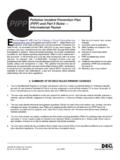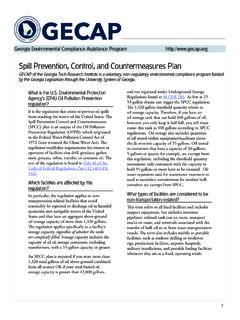Transcription of GUIDANCE NOTES FOR PREPARING OIL POLLUTION …
1 GUIDANCE NOTES FOR PREPARING OIL POLLUTION emergency PLANS For Offshore Oil and Gas Installations and Relevant Oil Handling Facilities December 2016 Introduction 1 Crown copyright December 2016 You may re-use this information (not including logos) free of charge in any format or medium, under the terms of the Open Government Licence. To view this licence, visit or write to the Information Policy Team, The National Archives, Kew, London TW9 4DU, or email: Any enquiries regarding this publication should be sent to us at Offshore Inspectorate, Department of Energy and Climate Change Department for Business, Energy and Industrial Strategy, AB1 Building, Crimon Place, Aberdeen, AB10 1BJ Atholl House, 86-88 Guild Street, Aberdeen, AB11 6AR. Email: Telephone: 01224 254138.
2 Introduction 2 This document is available from our website at Introduction 3 Revision Date Comment 0 January 2015 First Issue 1 May 2015 Amended to reflect industry comments 2 August 2015 Amended version issued following implementation of amendments to the OPRC Regulations. 3 December 2016 Amended to address queries arising throughout 2015 and 2016. Table of Contents 1. Introduction _____ 4 2. LEGISLATIVE BACKGROUND _____ 5 The OPRC Convention _____ 5 The Offshore Safety Directive _____ 5 The Amended OPRC Regulations _____ 5 The Offshore Installations ( emergency POLLUTION Control) Regulations 2002 _ 6 OPEP Approval _____ 6 Inspection, Regulatory Compliance and Enforcement _____ 7 Offences _____ 7 3. When is an OPEP Required? _____ 9 How to determine if an OPEP is required _____ 9 Additional GUIDANCE for Pipeline Operators of Oil Handling Facilities that are Pipelines (Pipeline Operators) _____ 9 4.
3 Administrative Process _____ 11 OPEP Submissions / OPEP Submission Cover Sheet / Assessment Template and Acknowledgement _____ 11 Responsibility for OPEP Submission _____ 12 Regulatory Review Period _____ 12 Temporary Operations OPEP (TOOPEP) Drilling Operations / Workover / Intervention _____ 13 Communication and Interface Plans _____ 13 OPEP Submissions in relation to new Safety Cases _____ 13 OPEP Submissions in relation to Material Change(s) to a Safety Case _____ 13 Consultees _____ 13 The Department Assessment Process _____ 13 Clarification Requests _____ 13 Non-Approval Issues _____ 14 OPEP Approval and Controlled Copies _____ 14 Major and Minor Changes _____ 15 Minor Changes _____ 15 Material Changes to a Safety Case or certain documents required to be submitted to the Competent Authority under SCR2015 and PFEER _____ 16 Major and Minor Changes _____ 16 Introduction 2 Five Year Review _____ 18 Cessation of Productions Withdrawal of OPEPs and Communication and Interface Plans_____ 19 Freedom of Information / Environmental Information Regulation Requests _____ 19 Financial Responsibility _____ 19 Appendix A Structure and Content of OPEPs _____ 21 OPEP Types _____ 21 Onshore OPEP _____ 22 Production Installation / Field OPEP _____ 22 Temporary
4 Operations OPEP (TOOPEP) _____ 22 Consolidated OPEP _____ 22 Non Production Installation (NPI) OPEP _____ 22 Temporary Operations OPEP (TOOPEP) _____ 23 Communication and Interface plan _____ 23 Pipelines _____ 24 Suspended and Abandoned Wells _____ 24 Installations not in Offshore Waters _____ 24 Decommissioning _____ 24 Operations from Vessels _____ 25 OPEP Type Requirements _____ 26 OPEP Content Requirements _____ 27 OPEP Assessment Templates_____ 29 GUIDANCE on Requirements for Consolidated OPEPs _____ 30 GUIDANCE on Requirements for Non Production Installation (NPI) OPEPs ___ 44 GUIDANCE on Requirements for Communication and Interface Plans _____ 47 Appendix B Modelling GUIDANCE _____ 50 Requirement to Follow OPEP Modelling GUIDANCE _____ 50 Modelling Requirements _____ 50 Categories _____ 50 Model Input _____ 51 Model Output Requirements _____ 51 Appendix C Training and Exercises _____ 56 Training _____ 56 Exercises _____ 57 Retention of Records _____ 63 Appendix D Oil Spill Reporting Arrangements _____ 64 Introduction 3 Appendix E Oil Spill Sampling Requirements _____ 66 Oil Sampling Capability _____ 66 When to Obtain Oil Samples from the Sea Surface _____ 66 Number of Samples to be Obtained _____ 66 Appendix F Dispersants Use and Approval _____ 67 Regulatory Regime _____ 67 Decision Making Process _____ 67 Request for Advice _____ 67 Standing Approval
5 _____ 68 Dispersant Use where Prior Approval is Required _____ 69 Dispersant Use to Protect Life or the Installation _____ 69 Record Keeping _____ 69 Dispersant Stocks _____ 69 Contacting the Department _____ 69 Appendix G Shoreline Response Planning _____ 73 Appendix H OCU Requirements _____ 75 OCU Interface Arrangements _____ 75 Roles and Responsibilities of Identified Positions _____ 75 OCU Room Requirements _____ 76 Appendix I Aerial Surveillance Requirements _____ 77 Appendix J Definitions and Abbreviations _____ 79 Definitions _____ 79 Abbreviations _____ 83 Introduction 4 1. Introduction This document provides GUIDANCE to Installation Operators, Well Operators and Owners of Non Production Installations for all offshore oil and gas operations conducted in the territorial sea adjacent to the UK or any area designated under section 1(7) of the Continental Shelf Act 1964.
6 For simplicity, Installation Operators, Well Operators and Owners of Non Production Installations will be referred to as Responsible Persons throughout this document. In addition, any Pipeline Operator or Operator of an Oil Handling Facility requiring an Oil POLLUTION emergency plan (OPEP) should utilise this GUIDANCE . For the purposes of this GUIDANCE and as per The Merchant Shipping (Oil POLLUTION Preparedness, Response and Co-operation Convention) Regulations 1998 (as amended) (OPRC Regulations), operators of pipelines are defined as Operators of Oil Handling Facilities . For the purposes of this GUIDANCE and as per The Merchant Shipping (Oil POLLUTION Preparedness, Response and Co-operation Convention) Regulations 1998 (as amended) (OPRC Regulations), Installation Operators, Well Operators and Owners of Non Production Installations are referred to as Responsible Persons.
7 Operators of pipelines and relevant Oil Handling Facilities are defined as Operators of Oil Handling Facilities . An OPEP is a legally required emergency response document which will facilitate the implementation of a robust and effective response to an oil POLLUTION incident and minimise the impact on the marine environment. Persons who submit an OPEP are reminded that OPEPs may be made publicly available. Applicants are reminded that an OPEP is a publicly available document which is owned, maintained and implemented by the Responsible Persons. This GUIDANCE supersedes all previous OPEP GUIDANCE issued by the Department of Energy and Climate Change the Department for Business, Energy and Industrial Strategy (the Department). LEGISLATIVE BACKGROUND 5 2. LEGISLATIVE BACKGROUND The International Convention on Oil POLLUTION Preparedness, Response and Cooperation was adopted by the International Maritime Organisation (IMO) in 1990.
8 The Oil POLLUTION Preparedness, Response and Cooperation Convention (OPRC Convention) came into force in the United Kingdom (UK) on 16 December 1997 and was implemented, in part, through The Merchant Shipping (Oil POLLUTION Preparedness, Response and Co-operation Convention) Regulations 1998 (the OPRC Regulations). The OPRC Convention The International Convention on Oil POLLUTION Preparedness, Response and Cooperation (OPRC Convention) as adopted by the International Maritime Organisation (IMO) in 1990 entered into force in the United Kingdom (UK) on 16 December 1997 and was implemented for offshore oil and gas operations by the OPRC Regulations. The OPRC Regulations require that all operations carried out on or in relation to an offshore installation or pipeline (including decommissioning) which may present a risk of marine POLLUTION by oil are the subject of shall have an OPEP approved by the Secretary of State for Energy and Climate Change.
9 The Offshore Safety Directive On 28 June 2013 EU Directive 2013/30/EU on the safety of offshore oil and gas operations (The Offshore Safety Directive - OSD) was published. OSD requires that certain information regarding emergency response measures is included in the Internal emergency Response plan (IERP) which forms part of the Report on Major Hazards (Safety Case). In the UK the IERP is delivered jointly by the OPEP and the emergency response plan required by PFEER. The requirements of the OSD must be fully transposed by 19 July 2016 for Non Production Installations and 19 July 2018 for Production Installations (including connected infrastructure). In order to implement those elements of the IERP relating to oil POLLUTION response the OPRC Regulations were amended on 19 July 2015. The amended regulations introduce the concept of the Responsible Person and require that the Responsible Person or Operator of the oil handling facility must have an OPEP in accordance with requirements the amended OPRC Regulations which must be prepared in accordance with this GUIDANCE .
10 The Amended OPRC Regulations The OPRC Regulations apply to all UK waters and in any area designated under the Continental Shelf Act 1964 and state that that every Responsible Person and operator of LEGISLATIVE BACKGROUND 6 relevant oil handling facilities must ensure that all offshore oil and gas operations for which they are responsible are subject to an OPEP approved by the Secretary of State for Business, Energy and Industrial Strategy. The Department requires that OPEPs are in place for all operations in relation to offshore installations, connected infrastructure, oil handling facilities or wells which present a risk of an oil POLLUTION incident. For the purposes of the OPRC Regulations and this GUIDANCE all pipelines that are not connected infrastructure or any facility that would be an Offshore Installation were it located in Offshore Waters are considered to be oil handling facilities.












